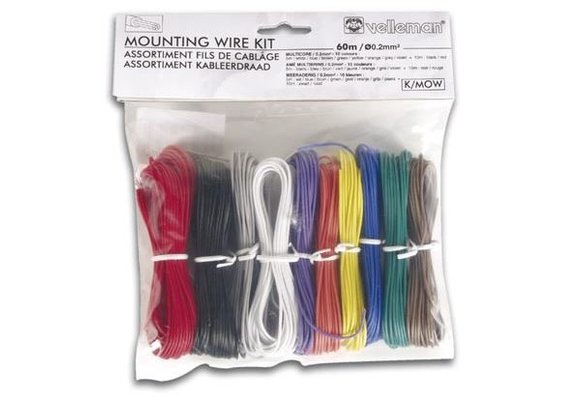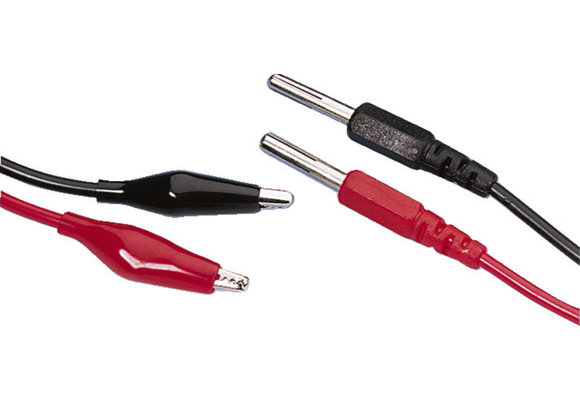A test probe is a physical product that connects electronic test equipment to a device that is being tested (DUT). Test probes range in complexity from simple, reliable devices to complicated, sophisticated, costly, and fragile probes. Test probes, oscilloscope probes, and current probes are examples of specific types. A test probe, which includes the probe, cable, and terminating connector, is frequently supplied as part of a test lead.
Test leads are more than just a way to link your digital multimeters (DMMs) to the tested device; they are also an essential aspect of the whole system. If you touch live wires that the metre has read as being de-energised, poor-quality, old, or under-rated test leads can cause inaccurate readings, which will constitute a severe shock or electrocution threat.
Here at SoundImports, you can buy test leads from our premium-brand Monacor!
How to use test leads
Before beginning any test, double-check that the DMM and test leads are suitable for the category and the voltage level utilised in the electrical environment.
Perform a visual inspection of the test leads before utilising them. Do this to ensure that they are safe to use and to conduct electrical signals accurately. The condition of the test leads is the most relevant element affecting your measurements in most cases.
Also, ensure that there are no cracks at the junction between the insulated wire and the moulded banana plugs or probes at each end. Though the visual inspection cannot guarantee that the test leads are safe, it can reveal apparent faults that can lead to injury.
Conduct a simple ohm's measurement to check that the test probes are electrically reliable and able to transport a signal within acceptable loss constraints. Place your DMM in the resistance (ohms) function, plug the leads into the DMM, and touch the probe tips together—red to black—to "ohm-out" your leads. For good quality test leads, the metre should read about 0.5 ohms or fewer.
Before taking any measurements, double-check that the leads are plugged into the correct DMM connectors and that the metre is set to the correct function.

 Home audio
Home audio  Audio components
Audio components  Crossover components
Crossover components  Test & measurement
Test & measurement  DIY kits
DIY kits  Accessories
Accessories  New products
New products  Speakers
Speakers Amplifiers
Amplifiers DAC converters
DAC converters DSP modules
DSP modules Turntables
Turntables Streamers
Streamers Woofers
Woofers Tweeters
Tweeters Exciters
Exciters Bass shakers
Bass shakers Plate amplifiers
Plate amplifiers Amplifier modules
Amplifier modules Single board computers
Single board computers Assembled crossovers
Assembled crossovers Printed Circuit Boards (PCB)
Printed Circuit Boards (PCB) Capacitors
Capacitors Resistors
Resistors Coils
Coils Circuit Breakers
Circuit Breakers Crossover tools
Crossover tools Screw terminals
Screw terminals Acoustic measurements
Acoustic measurements Electric measurements
Electric measurements Sound level meters
Sound level meters DIY amplifier kits
DIY amplifier kits DIY component packs
DIY component packs DIY speaker kit
DIY speaker kit DIY subwoofer kits
DIY subwoofer kits DIY bluetooth speaker
DIY bluetooth speaker DIY electronics kits
DIY electronics kits Binding posts
Binding posts Cabinet Hardware
Cabinet Hardware Cables
Cables Connectors
Connectors Speaker cabinets
Speaker cabinets Electromechanics
Electromechanics Power supplies
Power supplies Speaker repair
Speaker repair Workshop & tools
Workshop & tools Amplifier accessories
Amplifier accessories Stands & mounts
Stands & mounts Gift voucher
Gift voucher Books
Books New products
New products









 Speakers
Speakers Amplifiers
Amplifiers DAC converters
DAC converters DSP modules
DSP modules Turntables
Turntables Streamers
Streamers Woofers
Woofers Tweeters
Tweeters Exciters
Exciters Bass shakers
Bass shakers Plate amplifiers
Plate amplifiers Amplifier modules
Amplifier modules Single board computers
Single board computers Assembled crossovers
Assembled crossovers Printed Circuit Boards (PCB)
Printed Circuit Boards (PCB) Capacitors
Capacitors Resistors
Resistors Coils
Coils Circuit Breakers
Circuit Breakers Crossover tools
Crossover tools Screw terminals
Screw terminals Acoustic measurements
Acoustic measurements Electric measurements
Electric measurements Sound level meters
Sound level meters DIY amplifier kits
DIY amplifier kits DIY component packs
DIY component packs DIY speaker kit
DIY speaker kit DIY subwoofer kits
DIY subwoofer kits DIY bluetooth speaker
DIY bluetooth speaker DIY electronics kits
DIY electronics kits Binding posts
Binding posts Cabinet Hardware
Cabinet Hardware Cables
Cables Connectors
Connectors Speaker cabinets
Speaker cabinets Electromechanics
Electromechanics Power supplies
Power supplies Speaker repair
Speaker repair Workshop & tools
Workshop & tools Amplifier accessories
Amplifier accessories Stands & mounts
Stands & mounts Gift voucher
Gift voucher Books
Books New products
New products




